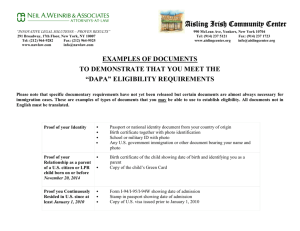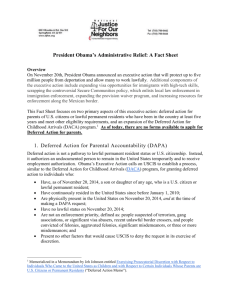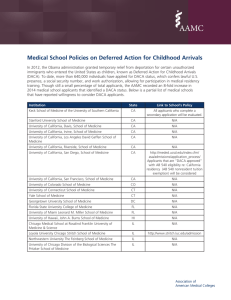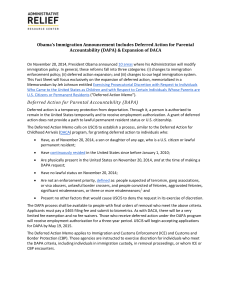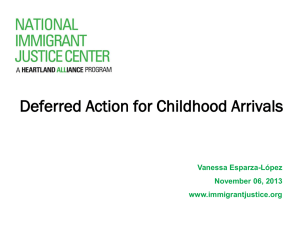U Visa Training
advertisement
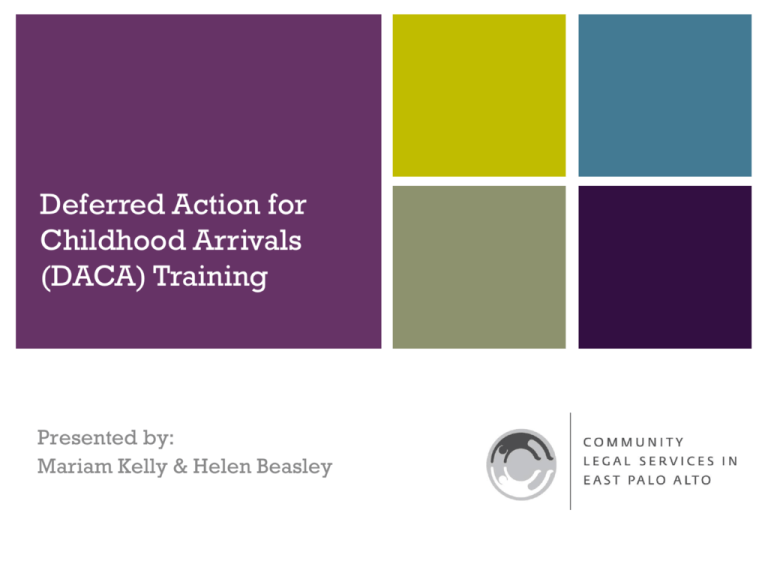
Deferred Action for Childhood Arrivals (DACA) Training U Visa Training Presented by: Mariam Kelly & Helen Beasley What is Deferred Action for Childhood Arrivals? An executive order signed in June 2012 by President Obama Allows undocumented individuals who were brought to the United States (U.S.) as children to be safe from deportation and to work legally in the U.S. What’s the benefit of “Deferred Action”? Will not be placed into removal proceedings or removed from the U.S. for 2 years from the date of being granted deferred action (unless terminated) Eligible to work legally in the U.S. with an employment authorization card (EAD) Can apply for state ID cards, driver’s licenses, and Social Security cards Who is eligible for DACA? Must prove through documentary evidence that: Arrived in the U.S. before turning 16, and before June 15, 2007 Have resided in U.S. continuously since June 15, 2007 and through to present day Were born no earlier than June 15, 1981 (aged 30 or under as of June 15, 2012) Currently be in school, have graduated from high school, have obtained a general education development certificate, or are honorably discharged veterans of the Coast Guard or Armed Forces of the U.S. Have not been convicted of a felony offense, a significant misdemeanor offense, multiple misdemeanor offenses, or otherwise pose a threat to national security or public safety. DACA Is Valid for 2 Years, Can Be Renewed As of June 4, 2014, people who were granted DACA in 2012 are nearing end of two-year grant period DACA is renewable, must affirmatively file for renewal New I-821D Form allows for requests for both Initial DACA applicants and Renewal Applicants INITIAL (First-Time) DACA REQUESTS What forms should be included in a DACA application? USCIS Forms: Form G-28: Notice of Appearance as Attorney or Representative (must always be included UNLESS case is handled in clinic) I-821D: Consideration of Deferred Action for Childhood Arrivals (form updated June 4, 2014) I-765: Application for Employment Authorization I-765WS: Employment Authorization Worksheet G-1145: E-Notification of Application/Petition Acceptance I-821D Must use most recent version of the form (6/4/2014) List name of client exactly as it appears on identity document (passport, birth certificate). Include both last names. Do not add hyphen unless it appears on identity document that way. Education Information: if client is currently in high school, list date of last attendance (likely same day as clinic) Preparer Information: List your name, Business/Organization name is FREE DACA CLINIC, sign your own name Interpreter Information: List Interpreter’s contact information if client is not a fluent English speaker I-765 False Social Security Numbers- DON’T include them On I-765 and supporting documentation for continuous physical presence I-765: Manner of Entry: B1/B2 Visa Entry with tourist visa No Lawful Status Covers Entry without Inspection, Entry with Fraudulent Documents, Waive-Through Checkpoint Current Status: No Lawful Status- DACA Applicant Eligibility Category: (c)(33) I-765 Worksheet (WS) Must be included Does not require signature Does not require supporting documentation Numbers need not be exact G-1145: E-Notification of Application/Petition Acceptance Optional form Does not require signature Allows applicant to get an email or text from USCIS when application is received by USCIS USCIS may use this as a tool to notify people about future renewal dates, other issues What else should be included? Cover Letter Proof of Age and Identity Proof of Educational Requirement Proof of Continuous Physical Presence (2007-Present) 2 U.S. passport photos (name and date of birth on back in felt pen) Money order for $465, made payable to U.S. Department of Homeland Security Proving Age and Identity Copy of Birth Certificate with Certified English translation Copy of Passport from Applicant’s country of citizenship Other government-issued photo identification, such as Matricula Consular Student Identification card (issued by school, with photo) Proving Educational Requirement Copy of High School Diploma Copy of school transcript (if still in high school) Copy of GED Equivalency Certificate Proof of enrollment in GED program (personalized letter from program proving enrollment, copy of class schedule with Applicant’s name and date) Proof of enrollment in classes to build skills for GED (i.e. English as a Second Language classes) Proving Continuous Physical Presence School transcripts, report cards, schedules, awards, certificates, ID cards, class photos with names/dates Medical records: vaccination records, log of doctor visits, hospital stays, dental records, prescriptions in client’s name Tax returns (so long as Applicant’s name appears somewhere) Bills, receipts, tickets, photo badges, dated photographs If nothing else available: affidavits, declarations from trusted sources, social media (i.e. location check-ins) If any absence from US: provide details in declaration Proving Continuous Presence, cont. Practice Pointer: Anything from a trusted source with applicant’s name and a date on it. Need 2-3 types of proof per year of physical presence. Need not have something for each month of each year! Do include documents dated as close as possible to: June 15, 2007 AND June 15, 2012 Client can’t pay? USCIS Fee Exemption Limited and need to apply in advance For extreme cases External Agencies Self-Help Federal Credit Union Mission Asset Fund Loan from San Mateo Credit Union Simple DACA vs. Complex DACA Simple Cases: Tend to be done en masse (in clinics) or pro se Complex Cases: Clean record, no immigration violations, no former deportation order, no contact with Immigration and Customs Enforcement Fairly straightforward, high grant rate, are usually processed quicker Arrest history: juvenile arrest, minor arrest as an adult Immigration violations: outstanding removal order, expedited removal at the U.S. border, voluntary departure but never departed, possible immigration fraud Gaps in physical presence Needs individualized, ongoing representation in event of additional Request for Evidence (RFE) by USCIS Requires Supervisory Review at USCIS (6 months or more to process) DACA RENEWAL REQUESTS DACA Renewal A new Form I-821D allowing for renewal applications was issued by USCIS in June 2014 DACA Renewal applicants must file for renewal at least 120 days, but no more than 150 days prior to the expiration of their employment authorization document Example: Expiration date is November 17, 2014 Applicant should apply for renewal no earlier than June 20, 2014 and no later than July 20, 2014 USCIS said it will make every effort to process renewal applications as timely as possible, if made within 120 days of expiration DACA Renewal vs. Initial DACA Filing No Supporting Documentation Necessary, most cases will only need to include the following: Forms I-821D; I-765; I-765WS, G-1145 Money Order for $465 payable to U.S. Department of Homeland Security 2 passport style photos Skip Part 3 of I-821D: Need not list all prior address, only new addresses since receiving DACA approval Do not need to submit proof of continuing or completing educational requirement How do Eligibility Changes Affect DACA Renewal? Travel: Traveling outside of the U.S. with advance parole is okay, so long as the person traveled within the timeframe granted by USCIS Traveling outside the U.S. without advance parole automatically terminates DACA. This becomes a complex case- should not be done in a clinic. Arrests: DUI, felony, significant misdemeanor, and possibly non-significant misdemeanors can make a person ineligible for DACA Renewal Any kind of arrest history post-DACA grant: complex case, should not be done in a clinic. DACA Expired for One Year or More: If DACA grantee has not applied for renewal one year or more after expiration of employment authorization card, they cannot renew and instead must apply as “initial applicant” General Do’s and Don’ts DO urge clients to respect the law and avoid arrests DO provide certified translations for all non-English documents submitted with application DO make sure your client has a copy of everything sent to USCIS DO have your client sign all forms in blue ink DON’T send original documents to USCIS DON’T use tabs, use color page separators instead DON’T hesitate to contact CLSEPA if you have any questions What happens after DACA package is submitted? Within 2-3 weeks: Receipts arrive for I-821D and I-765 Within 4 weeks: Biometrics Appointment Notice sent to client Within 3 months: Request for Evidence (if any) sent, or approval (simple cases) Within 6 months: if no response from USCIS, client can call USCIS Customer Service for more information about processing time DACA and Travel While DACA and/or DACA Renewal is pending: No travel outside of U.S. Air travel within U.S. only if person has valid, non-expired state-issued ID After DACA approval: Flights within continental U.S., Hawaii, Alaska OK (must have state-issued I.D.) Travel outside the U.S. (including Puerto Rico, U.S. Virgin Islands) Must have advance parole approval prior to travel (I-131) Travel must be for educational, employment, or humanitarian reasons (i.e. study abroad, or dying relative) What to Expect During DACA Clinic? Attorneys/Paralegals matched with DACA client Supporting documentation organized, forms drafted Final review by CLSEPA attorney Questions? Joyce Song, Pro Bono Director, jsong@clsepa.org Mariam Kelly, Immigration Staff Attorney, mkelly@clsepa.org
